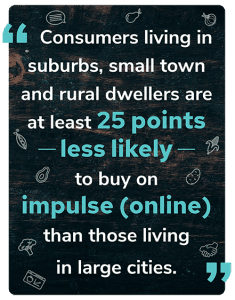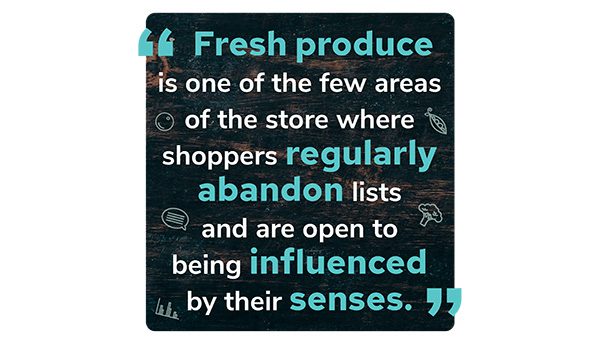Shopping for groceries online can be a win or a loss, depending on your point of view.
Many consumers like that they are able to plan their shop, add items quickly, and stick to a list. But that’s not so great for items bought on impulse, especially that attract shoppers with beautiful displays, like fresh produce.
How do we balance the needs of consumers and the produce industry, spurring demand but also maintaining a seamless online grocery experience? Who’s more likely to buy on impulse online, and how do we encourage retailers to incorporate suggestive selling strategies?
Tom Barnes, CEO at Category Partners said:
“Consistent with previous Category Partners research, impulse for many fruit categories, for example, are above 60% of purchases (in-store). That is a tremendous amount of opportunity and conversely a lot of volume at risk. But it is a basic fact that consumer buy produce with their eyes. So if they don’t see it, they won’t buy it.
Getting noticed, in-store, is a different nut to crack than online. Online shopping engines are fantastic at reminding you of previous purchases. We can all think of times we have received that “you previously purchased” or “It may be time to restock” reminder. Previous online purchases are a great way of encouraging future ones. But how do you start that “future history”?
Things as basic as online ads on retailer sites to promote an item might be one way. Perhaps in-store signage that promotes an online only purchase discount if you scan the QR code in-store? As an industry, we need to get creative. We MUST break the initial purchase barrier. If we don’t we will be fighting from behind for consumer attention against competition with much bigger budgets.”
Blue Book Services has teamed with Category Partners to delve into consumer habits in this series, Online Produce Shopping: the Path Forward.
This study yielded some interesting results. In particular it helped define who is purchasing online as compared to in-store. But it didn’t stop there. Category Partners examined the relevance of impulse purchases in-store and online, who is buying on impulse by channel and why we should care who they are.
Study sponsor Jim Beagle, CEO of Grapery (grower and marketer of Cotton Candy Grapes) BB #:210849 observed:
“Google the subject of consumer attention span on a web page, or Instagram or…you pick the social media platform.
Consumers engage or move on in almost the blink of an eye. None of us has the luxury of a lengthy and detailed communication of our products to a single audience, much less multiple audiences. To have hope of winning, particularly online, we have to know exactly who we want to, or need to, reach and what will potentially engage them. Laser like audience, message and imagery focus is pretty much life or death online.
It also applies to the social media platform where you might invest your marketing spend. Instagram is a platform that tends to be more dominated by a female audience, whereas males are generally found more on YouTube. Again, to borrow an old phrase, you have to fish where the fish are. That is more important today than it has ever been.”
According to Category Partners research, fewer than half of consumers, 48 percent, said they impulse shop for groceries online.
When they do, it’s men more often than women (+21 percentage points) who are swayed to make an unplanned purchase. This is a behavior that appears to be driven by the channel not by gender. When shopping in-store, men and women are evenly likely (64% to 68%) to buy on impulse. Younger, consumers, too, are much more likely to impulse buy online. Consumers 44 and younger were at least 20 percentage points more likely to buy on impulse than consumers 45 and older.
“In this study we did not specifically ask males or younger shoppers why they are more likely to shop for produce online. In part, because prior to the research we didn’t have objective evidence that these demographic segments might be interesting or important impulse purchase drill down,” says Cara Ammon, SVP of research for Category Partners.
“With that in mind, we can think back to earlier Category Partners research and apply some previous learnings along with a little bit of common sense. Grocery shopping online is still relatively new. Shopping for produce online is a behavior that, for practical purposes, is barely older than 24 months. Older demographics are not typically early adopters. Some of the data suggests, does not confirm but suggests, that those consumer segments who do not tend adopt early will tend to be more conservative in their approach to engagement. In other words, more planned purchases.”
 Population density also is a big factor in online impulse purchase. Consumers living in less-densely populated areas are less likely to make an impulse purchase online. Consumers living in suburbs, small town and rural dwellers are at least 25 points less likely to buy on impulse (online) than those living in large cities.
Population density also is a big factor in online impulse purchase. Consumers living in less-densely populated areas are less likely to make an impulse purchase online. Consumers living in suburbs, small town and rural dwellers are at least 25 points less likely to buy on impulse (online) than those living in large cities.
The research results hinted at a variety of factors impacting the online impulse purchase. Younger consumers more often live in large cities than older consumers. In addition fulfillment methods appear to be a driving factor as well. Delivery to home (as opposed to pick up at the store) is the preferred method in large cities. It is also more available than in less densely populated areas. Shopper age, convenience and delivery speed may be the important motivating factors at play in driving this impulse gap.
It’s not all about the beauty of an in-store display. Though this is an emerging segment of the industry, Beagle suggests some ways retailers and brands can make adjustments to spur online impulse purchase.
Grocers are “incredibly innovative” in their shopper engagement in a physical store, he says, particularly when it comes to fresh and perishable items.
“After all, fresh and perishable items are the biggest opportunity for grocers to differentiate from their competition, build their brand, and increase shopper loyalty for their banner,” Beagle says. “Fresh produce is one of the few areas of the store where shoppers regularly abandon lists and are open to being influenced by their senses. Through a variety of strategies, grocers give shoppers a multi-faceted sensory experience to offer them options that influence impulse purchase decisions.”
One of the best ways to sell in-store can be a challenge online.
“Seasonality in-store is a catalyst for shoppers, retailers, and producers to all ‘win’ in the experience,” Beagle says. “The early phases of online shopping have diverged from those opportunities, which opens the door for innovative new approaches for shopper engagement and excitement in an online shopping environment.”
Retailers engage a few strategies for seasonal produce success.
“Creating an online environment that gives a prominent stage for exciting seasonal products can be done through a variety of tactics that can include things like seasonal highlights, ripeness scales for consumers to have more choice in how their fresh produce is chosen, flavor guides for consumers to engage in a treasure hunt for the best tasting peak produce possible, and creative content around seasonal recipes,” Beagle says.
“All those tactics feed into larger opportunities to strategically engage shoppers in a way that is more than just an online food fulfillment catalog, and is more of a lifestyle fulfillment experience. People are passionate about food. Grocers and producers can work together to engage and connect with those passions in an online environment so that online grocery shopping becomes a sustainable strategic part of our fresh produce industry for everyone,” Beagle concludes.
Watch the discussion here:



